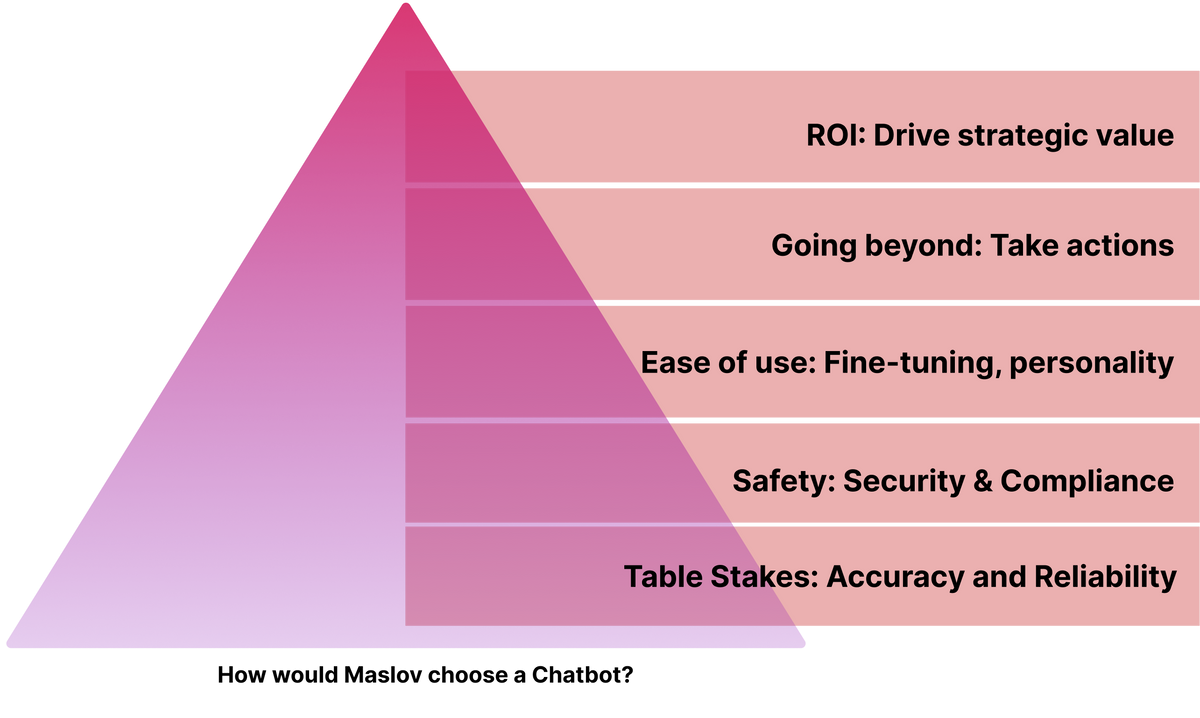Chatbot Buyers Guide: Five Things You Need In an AI Chatbot

The emergence of generative AI in customer support has been nothing short of transformative. The ability of these AI models to generate human-like responses has given businesses a powerful tool to enhance user experience and scale support operations. Advances in chatbot technology and artificial intelligence have driven the evolution of customer support solutions, enabling more natural, efficient, and automated interactions.
However, for potential buyers, distinguishing between many AI chatbot applications might seem like a herculean task. Each claims superiority, making it crucial for organizations to discern the actual value and select the one that fits their unique requirements. Making a strategic chatbot investment in advanced, AI-powered solutions is essential to maximize business value and ensure seamless integration with existing systems.
Introduction: Why AI Chatbots Matter
In today’s fast-paced digital landscape, businesses are under constant pressure to deliver exceptional customer satisfaction while streamlining their operations.
Enter AI chatbots: Intelligent virtual assistants that have revolutionized the way customer service teams interact with users. These AI chatbots are designed to provide instant support, handle complex queries, and offer seamless interactions across multiple channels. With features like multilingual support and the ability to simulate natural, human-like conversations, AI chatbots empower customer service teams to improve customer service, resolve issues quickly, and deliver personalized experiences around the clock. By choosing the right customer service chatbot, businesses can not only meet but exceed customer expectations, ensuring every interaction is efficient, helpful, and satisfying.By choosing the right customer service chatbot, businesses can not only meet but exceed customer expectations, ensuring every interaction is efficient, helpful, and satisfying.
Maslow’s Hierarchy of Needs for Chatbot Buyers
Maslov’s Hierarchy of Needs is a psychological theory that explains human motivation based on ascending needs. When relating this to chatbots, it provides a structured framework to evaluate their capabilities.
Just as humans need to fulfill basic physiological needs before seeking esteem or self-actualization, chatbots, too, should master basic functionalities before advancing to more sophisticated tasks. As you move up the hierarchy, chatbots require increasing AI capabilities, such as natural language understanding, multilingual support, and the ability to learn from user interactions, to handle more complex and valuable functions.
This parallel provides a lens to evaluate and choose the ideal chatbot solution for enterprise needs. So let’s dive into what those needs look like for your chatbot search:
1) Physiological Needs: AI Chatbot Functionality
Like the physiological needs of air, water, food etc, these are the basic table stakes. You shouldn’t consider a bot that can’t do any of this:
- Ability to understand and respond to user queries in your support channels, like email, Slack, Discord, SMS or text, and live chat.
- Seamless integration with existing systems.
- 24/7 availability.
- Should not hallucinate. Should always give accurate and reliable answers.
- Ability to handle routine inquiries and routine tasks, such as answering frequently asked questions and providing instant answers.
- Delivers consistent responses to user inputs and ensures information is always up to date.
Note: Many solutions in the market don’t meet these essential criteria. Ask them about hallucinations
2) Safety Needs: Security and Compliance
Like our inherent need for safety and protection, a chatbot should ensure data security and regulatory compliance. Any bot falling short in these areas can be a liability:
- Robust data protection measures are in place.
- Compliance with critical regulations like GDPR and SOC2.
- Assurance of secure transactions.
- Transparency regarding data sharing practices with core providers.
Note: Established players tend to excel in this area. But many upstarts are taking this very seriously. If working with a startup, ask for their data security policy.
3) Social Needs: User Experience, Personality, and Multilingual Support
Drawing parallels with our social needs of belonging and love, chatbots should also cater to the emotional and experiential aspects of user interactions:
- Effective and pleasant interactions with users.
- Proficient understanding of natural language.
- Ability to translate into many different foreign languages.
- Ability to exhibit empathy and maintain context.
- Ability to understand user intent and interpret both written and spoken language, enabling more natural and human-like interactions.
- Proficiency in handling customer inquiries and customer questions, ensuring natural and engaging customer conversations.
- For admins - ease of training the bot on your knowledge base and updating the bot. Ideally, the bot’s performance should improve with the usage.
- For admins - Providing insightful analytics to gauge performance and user satisfaction. For more details, see the AI customer service bot.
Note: A chatbot that can balance end-user and admin experiences, and serves as a virtual assistant excelling in understanding user intent, spoken language, and customer conversations stands out.
If you get these three right, you could expect to see improvement in your KPIs. In the case of customer support, these KPIs could be:
- Customer Satisfaction Score (CSAT)
- First Response Time (FRT)
- Mean Time to Resolution
- Cost per Resolution
Beyond this lies nirvana or self-actualization, in the words of Maslov.
4) Esteem Needs: Going Beyond the Basics
Just as the need for esteem pushes humans towards accomplishment, chatbots at this level should not answer but go beyond the existing capabilities. These are novel capabilities such as:
- Ability to employ an ensemble of LLMs to meet your needs. E.g., at Alhena, we work with many private and open-source LLMs such as GPTx, Claude, and Llama (open-source). Most of the chatbots are based off OpenAI’s GPT, which comes with its baggage of IP infringement issues.
- Use of large language models to handle complex conversations and complex questions, delivering accurate responses even in challenging or ambiguous scenarios.
- Advanced AI agents that autonomously manage customer support tasks, going beyond basic chatbots that rely on pre-written scripts, and providing more sophisticated, adaptive, and personalized interactions.
- Provision of self service options, enabling users to independently resolve issues and find answers through intuitive AI-driven tools.
- Capability to take actionable steps, akin to natural agents. For example, can the chatbot create an order, cancel a transaction etc?
- Can it ask intelligent questions and generate qualified leads?
5) Self-Actualization Needs: Strategic Value
At the pinnacle, akin to human self-actualization, chatbots should be a strategic asset, not just a tool:
- Drive tangible business growth: For eg., by making your support automated, you could differentiate yourself from competitors who don’t have such capabilities.
- Guide visitors towards specific conversion actions.
- Automate complex processes, adding value and improving customer service efficiency.
Leveraging customer data, including purchase history and account details, enables chatbots to deliver highly personalized experiences and improve service quality. By integrating with backend systems, AI customer service chatbots and customer service chatbots can access customer data to tailor responses, recommend products, and resolve issues more efficiently.
Deploying chatbots and AI customer service chatbots across omnichannel support, including messaging apps, leads to significant cost savings by reducing operational expenses and streamlining support across all customer touchpoints.
Advanced chatbots support teams and support agents by automating routine work, while still allowing for human intervention and seamless escalation to a human agent or human agents when needed. This ensures that complex or sensitive issues receive the necessary human support and maintain the value of human interactions.
Integrating human support and maintaining human interactions is crucial for handling situations that require empathy, judgment, or a personal touch, ensuring a balanced approach between automation and human oversight.
AI assistants and customer service chatbots are increasingly vital in industries such as gaming companies, where the ability to quickly deploy chatbots across multiple channels creates strategic advantages, enhances user engagement, and supports business growth.
Note: Few chatbots truly achieve this level, offering strategic advantages to businesses.
Implementation and Integration: Making It Work in Your Ecosystem
Successfully deploying an AI chatbot goes beyond simply choosing the right solution—it’s about ensuring it fits seamlessly into your existing ecosystem. Modern AI chatbots leverage natural language processing, machine learning, and conversational AI to understand and respond to customer queries in real time, delivering relevant responses that feel natural and engaging. Look for a chatbot with a no-code interface, allowing your team to easily configure, deploy, and update the bot without deep technical expertise. Support for multiple languages, voice commands, and integration with your knowledge bases ensures your chatbot can serve a global audience and handle a wide range of customer interactions. Robust analytics capabilities provide ongoing insights into performance, helping you refine your approach and deliver consistently excellent service. With thoughtful implementation and integration, your AI chatbot becomes a powerful tool for seamless interactions and improved customer satisfaction.
Analytics and Performance: Measuring What Matters
To maximize the impact of your AI-powered chatbot, it’s essential to track and measure its performance using advanced analytics capabilities. Monitoring key metrics such as customer satisfaction, conversation completion rates, and first response times allows you to identify strengths and areas for improvement. By analyzing customer interactions, you gain valuable insights into user behavior, preferences, and pain points—enabling your support team to refine the chatbot’s responses and enhance the overall customer experience. A data-driven approach ensures your chatbot continues to evolve, delivering accurate, relevant answers and driving business outcomes like increased loyalty and revenue growth. By prioritizing analytics and performance, you position your organization to stay ahead of the competition and achieve lasting success with your AI customer service chatbot.
Conclusion:
Choosing the best AI chatbot for enterprise support is a nuanced process. As organizations navigate the sea of AI offerings, this framework provides clarity, guiding decisions that optimize user experiences and foster genuine business transformation.
In a world where AI is the cornerstone of digital interactions, selecting a chatbot that aligns with these five tiers ensures not just adequate support but also long-term business vitality and differentiation.
Ready to See an AI Chatbot that meets Maslov's all five?
Book a 15-minute demo, and we’ll put an Alhena agent on one of your real tickets. Watch as it magically retrieves, plans, and resolves in front of you.
At Alhena, we are leading the industry in transforming the customer support using an Agentic AI architecture.
- Learn More: Alhena AI For ECommerce, Alhena for Technical Teams
- Create and Test Your Own AI Agent for Free: Sign Up
- Read Customer Success Stories: Customer Success stories


